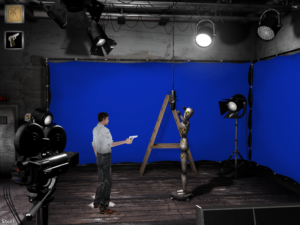The Final Cut: Continued Frustration
Before my last session, I would have said that The Final Cut is a game that has to be played twice: once to find out by trial and error what you’re supposed to do, and a second time to use your knowledge of the solutions to spot the clues that you were supposed to have noticed the first time round. But now, I have doubts that even this would be enough.
In the beginning of chapter 2, the detective finally meets his client, Robert Martin-Jordan, in person for the first time. Naturally he has a lot of questions. Some of these questions are about things that just plain haven’t happened. For example, one of the questions is about the things said on an audio tape that I had found, but had not yet found a means to listen to. (Perhaps he has the psychic power to divine the contents of audio tapes? I know there exists a man who can read the grooves on LPs…) Another of the dialog options is to tell him about how you were attacked up on the scaffolding. I had been up on that scaffolding, but there was no attack. All that happened there was a puzzlingly pointless first-person cinematic in which I pressed a button, after which the game returned me to the bottom of the now-unclickable ladder. Oh, and that somehow triggered the end of the chapter. I think I was doing things in the wrong order there.
The whole scaffolding scene had seemed incomprehensible at the time. (In retrospect, the button was probably the one mentioned elsewhere that turns the fire alarm on and off, but it didn’t seem to do anything. Unless perhaps the sound glitches prevented me from hearing the alarm. But if so, did I turn it on or did I turn it off? And either way, why?) But if I was attacked in that scene and didn’t notice, something was very wrong. So I found a walkthrough online to try to find out what was supposed to have happened there.
That walkthrough diverged from my experience of the game before it was even done with the intro movie.
After she leaves for bed, you observe a green car and have a momentary psychic flashback to the time your parents were killed in a car crash.
No I don’t! I saw the car, but there was no psychic flash, and this business about the detective’s parents is news to me. So at this point it looks like it’s just skipping over some of the cutscenes. But only some of them, which is odd. Maybe they’re using multiple codecs? Searching the web for reviews, I don’t see anyone else who had my problems. I see a lot of complaints about the story and the puzzles, but I guess my situation is like the Sirius Cybernetics Corporation in reverse: the more fundamental problems blind me to the surface flaws.
At least the walkthrough showed me something that I had genuinely missed on my own: I had failed to find the camera angle that lets you access the document giving all the characters’ names. This is something to be careful about, guys. If you’re going to make basic information missable, some people are going to miss it. Given that the rest of the game assumes that you have this information, it would have been a good idea to make leaving the prologue and proceeding to chapter 1 contingent on finding this document. Instead, the game makes it contingent on watching Mr. Martin-Jordan’s welcome video, which contains no information that’s useful once you’re out of the prologue.
It looks like this one is going back onto the shelf for a while, alongside Tender Loving Care. I seem to be having poor luck with technical problems in adventure games lately. You might think that adventures would be less prone to failure than big-name titles, being less technically demanding, but this also means that they’re typically developed on low budgets by small teams with tight deadlines. Also, their low replayability means that they often don’t get a lot of fan attention after release, ScummVM notwithstanding.
 Comments(3)
Comments(3)